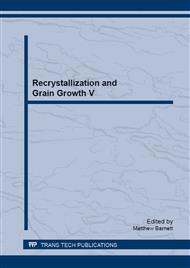p.231
p.235
p.239
p.243
p.247
p.251
p.257
p.263
p.267
Evolution of Microstructure and Texture in Friction Stir Processed Al-Mg-Mn Alloy
Abstract:
Friction stir processing was carried out on the Al-Mg-Mn alloy to achieve ultrafine grained microstructure. The evolution of microstructure and micro-texture was studied in different regions of the deformed sample, namely nugget zone, thermo-mechanically affected zone (TMAZ) and base metal. The average grain sizes of the nugget zone, TMAZ and base metal are 1.5 μm ± 0.5 μm, 15 μm ± 8 μm, and 80μm ± 10 μm, respectively. The TMAZ exhibits excessive deformation banding structure and sub-grain formation. The orientation gradient within the sub-grain is dependent on grain size, orientation, and distance from nugget zone. The microstructure was partitioned based on the grain orientation spread and grain size values to separate the recrystallized fraction from the deformed region in order to understand the micromechanism of grain refinement. The texture of both deformed and recrystallized regions are qualitatively similar in nature. Microstructure and texture analysis suggest that the restoration processes are different in different regions of the processed sample. The transition region between nugget zone and TMAZ exhibits large elongated grains surrounded by fine equiaxed grains of different orientation which indicate the process of discontinuous dynamic recrystallization. Within the nugget zone, similar texture between deformed and recrystallized grain fraction suggests that the restoration mechanism is a continuous process.
Info:
Periodical:
Pages:
247-250
Citation:
Online since:
March 2013
Authors:
Price:
Сopyright:
© 2013 Trans Tech Publications Ltd. All Rights Reserved
Share:
Citation:


